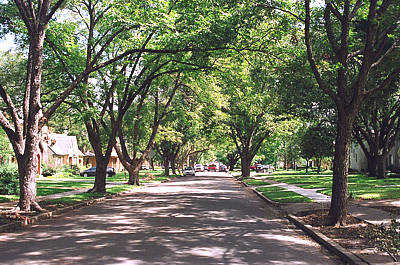 What is the Urban Heat Island? What is the Urban Heat Island?
Like many metropolitan areas, Dallas’ is affected by an
Urban Heat Island (UHI), which is caused by the large
concrete areas that are warmer than the natural rural areas.
Sometimes there is a 10-12 degree temperature difference
between the inner urban and rural areas. By its nature,
concrete, asphalt and buildings tend to absorb heat, and a
lack of trees as well as other plant life prevents natural
cooling from occurring. Additionally, the absence of
vegetation that naturally removes pollutants from the air
can lead to poor air quality.
The committee is working with various city departments,
including Dallas’ Environment Quality Department on reducing
the UHI effect. In 1995, Texas Christian University
professor, Dr. Ken Morgan, conducted the city’s first urban
heat island study, which showed a large section of central
and downtown Dallas having temperatures several degrees
warmer than the surrounding suburbs and countryside. In
2009, the
Environmental Protection Agency commissioned its own updated
study on Dallas’ urban heat island areas providing
further research on this issue. This heat effect can impact
not only Dallas’ environment, but also its quality of life
by having hotter than normal temperatures, higher energy
bills, and poorer air quality.
Trees Can Cool Dallas
Reducing the urban heat island affect is challenging
task; however, one effective tool shown to lower urban
temperatures and improve air quality is the planting of
trees. In fact, the 1995 study also revealed that Oak Cliff,
and its tree covered neighborhoods, had one of the coolest
temperatures compared to the rest of the city. Trees can
have a positive effect on urban heat island areas.
How Can Trees Reduce Dallas Temperatures?
Trees have many qualities well suited to reduce the urban
heat island affects:
- Large trees can provide shade to block the sun’s
heat.
- Trees have a “moisture emitting” process, otherwise
known as that cools the urban air
temperature by releasing moisture.
- Trees need carbon dioxide to survive, and through
its “breathing” or photosynthesis process, significant
amounts of carbon dioxide and other pollutants are
removed, such as sulfur dioxide or nitrogen oxide.
Taken together, trees can help cool urban temperatures
and cleanse the air, which improves Dallas’ quality of life.
What is UFAC doing to curb the Urban Heat Island?
UFAC is helping to reduce the UHI effect, by encouraging
various tree planting projects across Dallas - especially in
the concrete laden parts of our city. The
Adopt-A-Median project, increased planting in city parks and street medians,
inclusive of other key tree planting projects and obtaining
funding and support for such projects
are some of the ways UFAC is helping to restore trees to
Dallas urban areas and reducing the heat island effect.
|









